Position statement - Wildlife signs on Scottish Roads - July 2022
Introduction
This paper is intended to inform managers, designers and stakeholders with an interest in the use of warning signs as a means of reducing the occurrences of wildlife casualties on Scotland’s roads. It sets out the rationale behind the adopted position of the national transport agency, Transport Scotland, in determining what signs are appropriate for installation with regard to wildlife.
Context
The Traffic Signs Regulations and General Directions (TSRGD) sets out the signs and markings to be used on the Scottish road network, and the provisions for their use. The TSRGD is devolved to the Scottish Government.
Only signs currently included in TSRGD can be used on Scottish roads whilst signs not included in the regulations (non-prescribed signs) are not permitted to be used without approval by Transport Scotland, as the national transport agency for the Scottish Government.
In the course of applying the TSRGD, Transport Scotland has a duty to maintain safe and reliable roads that are easy for the users to read and understand. In addition, Transport Scotland is tasked with ensuring the road environment respects the local landscape, as far as practicable, whilst keeping the road side verges free from unnecessary clutter. Decisions regarding signage and other road furniture must meet these objectives and avoid potential hazards for road users and operatives through the unchecked proliferation of roadside structures.
Wildlife and signage
Transport Scotland is well aware of the issues linear infrastructure can cause for wildlife, such as habitat fragmentation and loss of connectivity, and works in partnership with NatureScot and other relevant organisations to manage the impacts associated with migrating wildlife and the road network. This embraces the introduction of a range of mitigation measures and actions, including warning signage where appropriate, as Transport Scotland seeks to balance the objectives for road safety and reliability with nature conservation and biodiversity enhancement.
Existing signs
TSRGD currently includes prescribed signs to warn road users of the likely presence of wildlife on, or crossing, the carriageway. The most commonly used sign is a generic style to cover all wild animals and is represented by the silhouette of a running deer, TSRGD diagram 551 (figure 1).
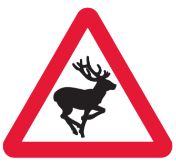
There is another prescribed sign that specifically warns of the potential presence of wild fowl, TSRGD diagram 551.2 (figure 2). Both signs may be supplemented by a plate beneath stating ‘for [defined distance]’.

In addition to these two signs, the regulations include a third sign depicting a toad, TSRGD diagram 551.1. Whilst a prescribed sign, this is for use in temporary situations only and, specifically, for known locations for seasonally migrating toads (figure 3).
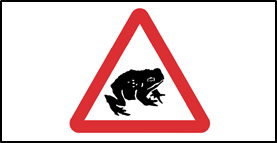
Other prescribed signs exist for domesticated animals such as cattle, sheep and accompanied horses as well as wild horses.
Small mammal signs
It has been suggested that the default wild animal warning sign – the silhouette of the running deer – is potentially misleading, as the obvious assumption is that this warns of the likelihood of deer being on the road ahead, rather than the intention that the sign represents any wild animal. Feedback, including communications at parliamentary level, has suggested that a sign (or signs) appropriate for smaller animals could be included in TSRGD. The intent of this feedback is predominantly focussed on protecting the animals, though it is acknowledged that smaller animals also have potential to create hazard by distracting the driver, and may be a particular hazard to two-wheeled vehicles.
In 2023 the Department for Transport (DfT) introduced a new small mammal warning sign for use by any local roads authority in England. The sign, depicting the silhouette of a hedgehog, is intended to represent smaller wildlife species such as otter, badger, red squirrel and hedgehogs etc. (see figure 4)
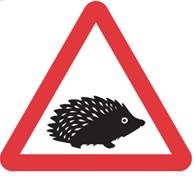
Figure 4 – Sign introduced in England to warn drivers of small mammals on the road.
DfT hopes the sign will help to warn motorists of the possible presence of such animals on the road, and therefore help prevent wildlife casualties and potential incidents leading to road user injuries.
The sign has not been included within the TSRGD and remains non-prescribed, but DfT has given blanket approval for use in England. The small mammal sign is not intended to be used in Scotland.
Individual species signs
Transport Scotland has received previous requests for non-prescribed sign approval for species-specific signage – for example, silhouette images of otter, badger and red squirrel etc. There are examples of such signs in existence in some remote locations (see figure 5). However, these signs have not been approved by Transport Scotland through the non-prescribed sign process, and are liable for removal.

The number of requests has prompted Transport Scotland to undertake a consultation exercise with NatureScot to understand whether the statutory nature conservation organisation (SNCO) considers there is any merit in the introduction of species-specific signage, bearing in mind Transport Scotland’s overarching objectives to maintain safe and reliable roads that are easy to understand.
Consultation and consideration
In order to gather input from specialists in wildlife conservation, Transport Scotland approached NatureScot, Scotland’s nature agency, for their considered opinion on the issue of wildlife signs. NatureScot has confirmed that it does not believe the roll-out of individual species signage is the most appropriate way to protect wildlife from road-related impacts, as drivers regularly habituate to signs that they do not immediately perceive as being relevant to themselves. The statutory nature conservation organisation also recognises there are limitations on the full effect of the existing wildlife warning sign (figure 1 above).
The COST 341 report: Wildlife & Traffic - A European Handbook for Identifying Conflicts and Designing Solutions, was an Infra Eco Network Europe (IENE 1998) initiative providing an overview of the scale and significance of the problem of fragmentation of natural habitats by roads and other linear infrastructure.
It came to the conclusion that whilst there is a place for warning signage, it should not be considered the solution to the problems recorded. It also suggested the efficacy of signs is further diminished as more signs are added to the road verges.
The European report determined that signs are most effective when they are more noticeable to the motorist through such measures as:
- limiting their use to only those places where there is a proven (not simply perceived) and significantly high risk of collisions between vehicles and wildlife;
- a programme of temporary use and removal to coincide with specific seasonal wildlife migrations;
- combining the sign with additional information, such as a speed limit or a simple description of the hazard,
- incorporating flashing lights that can be activated at pre-determined times or linked to vehicle approach speeds or movements in the lateral verge area.
Transport Scotland contributed to the preparation of the COST 341 report and supports the general conclusions in respect of wildlife road signage. All four suggested measures above, have been considered, including the trialling of speed-activated (flashing) wildlife warning signs (see figure 6).

The trial has recorded local benefits, but the units are very expensive in comparison with static road signs and they have also encouraged some drivers to increase speeds simply to activate the sign. Similarly, the temporary use of signs is considered to only have limited impact for driver speeds.
Reducing wildlife conflict
Wildlife mortality locations are often linked to the desire of animals to cross roads in search of food or to seek a mate. General risks also occur where good, supporting habitat is bisected by a road, impacting connectivity of movement and leading to fragmentation, with the divided sections of habitat less able individually to support the species populations.
Options are available to try to prevent wildlife reaching the carriageway, depending on the species involved, including fences, culverts and other artificial crossing systems. However, such mitigation measures are not always fully effective and can be inappropriate and impracticable in some situations.
It is generally considered that a best practice approach to reducing wildlife conflicts with roads is to identify and understand the range of factors influencing species movement in the local area, not just in the immediate vicinity of the road itself. Encouraging adjacent landowners to consider the wider impact of management operations and take action to protect, extend or develop safe habitat areas away from major road corridors can help safeguard local species populations and reduce potential conflicts.
Transport Scotland position
All reports and requests related to potential areas of conflict between wildlife and vehicles are considered in relation to the specific context of the site and local circumstances. It is often found that some problematic situations where signage is initially identified as the solution can be better mitigated through alternative measures, sometimes in partnership with adjacent landowners and other organisations.
Transport Scotland accepts that, where signage is considered a sensible approach, the existing wildlife sign may not be appropriate in all cases.
However, Transport Scotland does not believe that a bespoke, species-specific sign will add any greater level of protection to wildlife than is already afforded by the prescribed wildlife sign, and this view is supported by the feedback from NatureScot and as stated in other guidance.
The main consideration in the potential provision of species-specific signage is the likely significant increase this would realise in the number of warning signs in the road verge. This may be manageable if, for example, one species was selected to represent a number of others, such as the example of the small mammal sign used in England, or if the signage was restricted to one species only.
The general opinion, in terms of the former approach, is that the hedgehog sign (or similar) will not affect driver behaviour beyond an initial introductory period when intrigued motorists may note the sign for the first time and slow their speed to better view the image – particularly as the image is not immediately discernible from any significant distance. With the latter option, it is considered unrealistic to expect agreement across nature organisations and interest groups on only one type of single species sign - i.e. if only otter signs became prescribed for use, for example, this is unlikely to satisfy those campaigning for bespoke red squirrel or badger signs etc.
Transport Scotland remains unconvinced that either option is appropriate for the Scottish Trunk Road Network, in terms of effectiveness and operational safety, and it is considered sensible to continue with the current approach, outlined below.
Where requests are made for non-prescribed wildlife signage, consideration will be made of the individual circumstances, with the default position being to sanction the use of the standard, prescribed generic hazard warning sign representing ‘other danger ahead’ – the exclamation mark, TSRGD Diagram 562 (figure 7).
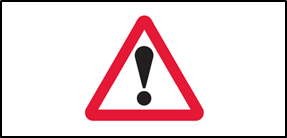
This sign may be supplemented with an additional plate below to provide more specific information about the identified hazard – e.g. ‘Caution otters’, sometimes with the extra information; ‘for [defined distance]’, (see figure 8). It should be noted that these supplementary plates are not currently prescribed in TSRGD and will require approval from Transport Scotland.
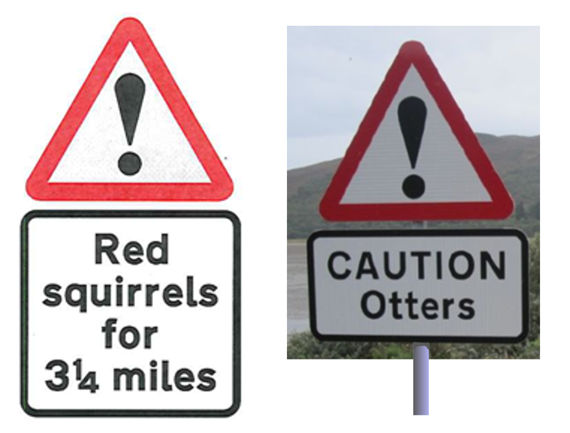
In this way, Transport Scotland can respond to specific circumstances where warning of wildlife conflicts is deemed appropriate, whilst continuing to proactively manage the number and types of signs used on Scottish trunk roads to ensure driver information remains focussed on what is required for the safe use of the network.
Conclusion
Transport Scotland continues to balance the various pressures on Scotland’s road verges through careful assessment of requests for new signage.
Transport Scotland does not support the introduction or use of new species-specific ‘silhouette style’ warning signs for smaller animals. However, species-specific supplementary plates used in association with the standard warning sign to TSRGD Diagram 562 may be considered on a case-by-case basis.
The use of these supplementary plates will be subject to approval through the non-prescribed signs process, so that Transport Scotland can ensure that their use is controlled and is only applied in appropriate circumstances.